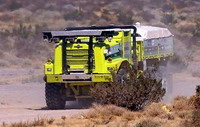Self-driving vehicle undergoes tests
Sitting high in the cab of the hulking lime-green TerraMax truck, a driver grabs the steering wheel.

There is no need. TerraMax is a self-driving vehicle, a prototype designed to navigate and obey traffic rules - all while the people inside, if there are any, do anything but drive.
During a recent test on property owned by manufacturer Oshkosh Truck Co., TerraMax barreled down a dusty road with its driver seat empty. It stopped at a four-way intersection and waited as staged traffic resolved before obediently lurching on its way.
If the Defense Department gets its way, vehicles like TerraMax - about as long as a typical sport utility vehicle and almost twice as high - could represent the future of transportation for the military's ground forces.
Consider 80 soldiers driving a convoy of 40 trucks across the Iraqi desert, said Joaquin Salas, spokesman for the company. If most of those vehicles could drive themselves, the same convoy might manage with just 10 soldiers.
"You're reducing the number of people susceptible to enemy fire," said Salas, who served eight years in the U.S. Marine Corps. "It's simply amazing technology."
Congress has mandated that one in three ground combat vehicles be self-driving by 2015. The idea is to free personnel for nondriving tasks such as reading maps, scanning for roadside bombs or scouting for the enemy - and to be able to deploy vehicles altogether unoccupied.
The military's research arm turned to industry and academia to help meet that goal. The Defense Advanced Research Projects Agency, or DARPA, has sponsored a series of contests since 2003 in which prototype vehicles must navigate rough terrain and avoid obstacles.
Oshkosh Truck, a public company that in August projected its 2008 sales would be about $7 billion (4.9 billion EUR), is fielding one of 35 teams whose vehicles passed qualifying tests this year. Some teams see the competition as a way to improve automotive technology.
"It's my view that we're not just trying to win but we're also trying to advance the topic of safer cars," said Sebastian Thrun, a computer-science professor who leads Stanford University's team. "There are so many other great uses of this technology."
Thrun called TerraMax "an amazing vehicle, very sturdy" but noted that the DARPA competition is more about software than hardware.
The software that controls TerraMax is Oshkosh's own. Teledyne Technologies Inc. company Teledyne Scientific Co. in Thousand Oaks, California, provided the path-planning technology, and VisLab at Parma University in Italy developed the vision systems.
On a recent afternoon, Oshkosh chief engineer John Beck programmed a course into TerraMax's onboard computer.The monitor displayed the truck's proposed path and a 360-degree view of its surroundings. External objects showed up as ambiguous red squiggles.
Humans can drive TerraMax, in which Salas said the company has invested "tens of millions of dollars." But once Beck pressed a button marked "Auto Drive," the steering wheel snapped into automated mode and the vehicle moved on its own.
After traveling at the programmed speed of 10 mph (16 kph), TerraMax jerked to a halt at a preprogrammed stop.
"That's one of the things we're working on," Beck said of the rough ride.
The 12-ton truck paused to allow its onboard sensors - lasers, sophisticated cameras and global positioning systems - to determine the roadway was clear. Then it dutifully signaled, executed a tight left turn and continued.
TerraMax safely avoided trucks driven by humans that passed through the same parking lot, and it obeyed traffic laws with such precision that a roadside observer might have believed a person was driving.
It takes only minutes for a passenger to trust the vehicle, just as one does not worry what the chauffeur is doing in a limousine. Beck said it's amazing how quickly people become comfortable in a self-driving truck.
"What's weird, though - it's not that comfortable when you step out of it and tell it to go by itself," he said. "For some reason it's a lot more scary watching it drive when there's no one in the cab. I don't know why."
It could be years before driverless vehicles are used regularly in combat. Some prototypes, such as the 6.5-ton "Crusher," a six-wheeled military vehicle that uses robotic technology developed at Carnegie Mellon University, are in testing. But while Crusher can maneuver rough terrain, it was not designed to navigate an occupied intersection.
Their early results were disappointing. In 2005, only five of 23 vehicles completed the 132-mile (212-kilometer) course, led by the Stanford team that won the $2 million (1.4 million EUR) top prize with its modified Volkswagen Passat station wagon.
This year's competition is expected to be stiff. Squads from the Massachusetts Institute of Technology and Cornell University are among those invited to participate in an Oct. 26-31 qualifying event in Victorville, California, along with industry teams that include employees of Delphi Corp. and Ford Motor Co. The entrants include modified cars, pickups and SUVs.
Salas said he is tempering his optimism about how TerraMax will do.
"Everybody's extremely competitive," he said. "We're so much further, the entire industry, than it was just two or three years ago. It's absolutely incredible how advanced the technology has become."
Subscribe to Pravda.Ru Telegram channel, Facebook, RSS!

